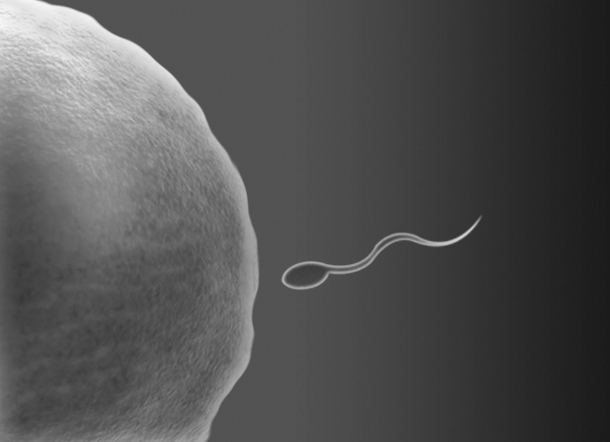The Troubling Decline in Fertility
Air Date: Week of July 16, 2021

Fertility worldwide has dropped nearly 1% per year from 1960 to 2018. Endocrine disrupting chemicals like PFAS and phthalates play a role in fertility decline by affecting male testosterone, diminishing sperm count, decreasing sperm quality, and increasing erectile dysfunction. (Photo: Zappys Technology Solutions, Flickr, CC BY 2.0)
Over the past four decades, sperm counts in many countries have dropped by more than 50%, and female fertility is also declining. Chemicals known as hormone disruptors are key culprits including PFAS and phthalates found in plastics. Shanna Swan, professor of Environmental Medicine and public health at Mount Sinai School of Medicine, led this groundbreaking research and is the author of the 2021 book, "Countdown: How Our Modern World is Threatening Sperm Counts, Altering Male and Female Reproductive Development and Imperiling the Future of the Human Race". Dr. Swan joins Host Steve Curwood to discuss the growing fertility crisis and why it hits vulnerable communities especially hard.
Transcript
CURWOOD: It’s Living on Earth, I’m Steve Curwood.
Before the break we talked about PFAS chemicals and their threat to human health. Now we turn to another group of chemicals, phthalates, which are a common ingredient in plastic made from fossil fuels and many other products including flooring and non-stick cookware. Like PFAS phthalates can mimic or interfere with hormone systems, and research is linking them to the decline in male fertility, including lower sperm counts and poor quality. Female fertility is also declining. Women today have a harder time conceiving than previous generations. The notion of polluting ourselves into a fertility crisis is exactly the premise of Margret Atwood’s novel, The Handmaid’s Tale. Made into a tv series, The Handmaid’s Tale is about a dystopian world in which the very few fertile women left are forced to bear children for the ruling class of a religious totalitarian government.
AUNT LYDIA: Fertility is a gift directly from God. He left you intact for a biblical purpose. Like Bina served Rachel. You girls will serve the leaders of the faithful and their barren wives. You will bear children for them. Oh, you are so lucky!
Shanna Swan is a professor of Environmental Medicine and public health at Mount Sinai School of Medicine and author of the book Countdown: How Our Modern World is Threatening Sperm Counts, Altering Male and Female Reproductive Development and Imperiling the Future of the Human Race. And she joins me now. Welcome back to Living on Earth Dr. Swan.
SWAN: Thank you, Steve, really happy to be here and talk to you again.
CURWOOD: So let's talk first about the behavioural part about this. What are things that we do to reduce our sperm counts in terms of our diet and habits?
SWAN: Well, some of them are pretty obvious. They're things that we worry about for our heart health and overall health, like smoking. So smoking is very strongly related to sperm count. And what people might not know is that the mother smoking and even the father smoking at the time he conceives the pregnancy can affect the semen quality in the son that was being conceived at that time. So smoking is the big actor. Extreme alcohol, binge drinking is really bad for sperm count. And then diet matters, as do the organic nature of the fruits and vegetables that you're eating. So we showed that when people ate organic fruits and vegetables, the men's sperm count increased. But when the fruits and vegetables were not organic, we didn't see that. Stress is important, the stress of daily life, we found that the number of life events that a man has in his daily life affects his sperm count. And so pretty much everything in our lives that we experience plays a role in our health, and particularly in sperm count.
CURWOOD: And what about the chemicals? What is that doing? What's the relationship between chemicals in this more than 50% decline in the sperm count in the last 40 years?
SWAN: We know something about several classes of chemicals, but we know much less than we should. So I've studied the role of pesticides. So pesticides we've shown are directly related to the sperm count, morphology and motility of sperm. And we showed that in a study where men in rural Missouri, where there's a lot of pesticides had only half as many moving sperm as men in Minneapolis, where there's very low pesticide use. And within that Missouri men, the amount of pesticide in their urine was directly related to their semen quality. So that was a pretty clear picture. We've also seen that phthalates, which are everyday chemicals in our daily lives, make plastic soft and flexible in our personal care products, and so on, that those chemicals, which can lower testosterone, are very important for male reproductive development, particularly when the male is in utero. And we did a whole series of studies showing that when the mother had higher levels of those phthalates in her urine, the sons were born with genital changes, which add up to them being less completely masculinized. And then we showed that those changes in adults were related to sperm count. So we made a link from in utero exposure to adult sperm function. But there are other classes of chemicals that matter, the bisphenols, the Pfoas, and so on. And we are just attacking those because each investigation takes millions of dollars and 10, 15 years. So it's a slow process and this should be cleared up before the chemicals go into the marketplace.

Exposure to endocrine disrupting chemicals during pregnancy can influence the baby’s reproductive system especially during early pregnancy and affect subsequent generations. These toxic chemicals are present in everything from skin care products to food and drinking water. (Photo: Muhirehussein12, Wikimedia Commons, CC BY-SA 4.0)
CURWOOD: Now, let's talk a little bit more about women. You write that women are now less fertile at a young age than their grandmothers once they hit 35. So that means that just within these last couple of generations, two or three generations, the fertility of women has fallen dramatically. What do you think are the main issues women are experiencing when they're trying to have a baby aside from of course, the issue of the quality of semen of sperm that they might be getting for this process?
SWAN: Right? Well, I think the first thing we have to consider and acknowledge is the role of age. So women's fertility and the number of eggs she has available, and the number of good eggs she has available, drops off rapidly once she passes about 30 to 34 years of age. And because couples are choosing for economic and other reasons to delay their first child, this pushing women into this area, this age range in which they're going to have more problems, they're going to have more miscarriage. That said, what the thing you quoted from our book, which is that women in their 20s have less fertility than their grandmothers did in their 30s. That is also going on and that's saying that even young women are having problems and that's not an aging problem. And I wanted to point out that a mother's exposure affects her offsprings reproductive health and inside that fetus are the germ cells that will produce the next generations children. But the point here is that if we are protecting ourselves, particularly if we're pregnant or for men who are about to conceive a pregnancy, they would be protecting at least three generations. So we have a big responsibility. The good news Steve, which I learned only recently, from Pat Hunt at the University of Washington, she showed that an animal's in the laboratory, you can take a male who's been exposed and has severe reproductive problems, his offspring and his offsprings offspring. If there are kept clean, kept unexposed to these chemicals, in three generations, they can recover their reproductive health. And that's kind of encouraging. Because these chemicals are not persistent most of them the ones we're exposed to today. Some like the PFAS are more persistent, but we're not looking at the old DDT and dioxin and PCBs of which were banned a long time ago, those very long life chemicals. But phthalates and phenols leave the body in four to six hours. So if we can stop them from coming in, we can clean up our mess.
CURWOOD: Part of the response to the fertility decline and perhaps might be fair to say even we're looking at a fertility crisis, although it seems silent at the moment, is that some folks will use reproductive tech, I'm thinking of in vitro fertilization for one. But you know the cost of that is then five figures, you're talking 10,000 $20,000, perhaps more, and repeat that a few times that becomes a piece of change, or hiring a surrogate to have one's child. So in other words not everyone can afford that this sounds to me, like a case also of environmental injustice, that reproductive rights for poor and underserved communities are affected by the inability to use this technology.

The first trimester of pregnancy is crucial for the reproductive development of the male fetus. Exposure to androgen chemicals can result in a shortening of the anogenital distance (AGD) which can in turn result in a smaller penis and a lower sperm count in adulthood. (Photo: Evan Amos, Wikimedia Commons, Public Domain)
SWAN: That is correct and I wanted to also add that disadvantaged communities we're seeing are actually more affected by these chemicals. I'll give you an example. We have a study in four cities in the United States. One of those studies is Rochester (New York). In Rochester, the Study Center is mostly Medicare, mostly African American, and they are having higher exposures we're seeing and the effect of those exposures, even at the same level are greater than in the other three centers, which are primarily middle class, primarily white, and have lower exposures. So again, three ways in which this is an unjust impact, greater exposure to disadvantaged communities, greater impact of a given exposure, and less opportunity to buy your way out of it, whether it's through assisted reproduction or safer foods, or safer personal care products.
CURWOOD: So what can people do? In light of this knowledge? What can people do to lessen their exposure, for example, to endocrine disruptive chemicals that might affect their ability to reproduce?
SWAN: So that's an important question. And it's something that we spend several chapters on in Countdown,our book, this is quite a big story. But I'll try to say a few things that people could do. So first of all I want to preface this by saying the things that people can do may be limited by their economic status. So food access, ability to afford organic foods, ability to afford personal care products that are cleaner and safer. Even having the time to go to the web to look up these products assumes a certain amount of free time and an economic status and an education that not everybody has. So there is an environmental justice issue connected to this question of what can people do and I want to stress that. Okay, so what can people do? Well I recommend that people to the extent they can eat unprocessed food and that's because the processing of food, once it's collected at maybe even an organic farm will introduce chemicals like phthalates and the bisphenols into the food. And we know that because we know that when food goes through plastic tubing, which is soft, it picks up the phthalates from the tubing, enters the food, gets into us, gets into your urine, the CDC can measure it and that's been shown in many settings including for babies in the NICU. So unprocessed food that doesn't go through plastic, isn't packaged in plastic isn't shipped in plastic and certainly is not heated and plastic will be much safer for you. Another thing you can do is try to worry about the things that your home that I like to think of as barriers. So a nonstick pan has a coating on it a Teflon pan has a coating on it right? To keep the food from sticking. That is an endocrine disrupting chemical it's one of the PFAS chemicals. The barriers on our clothing that keep off liquids or rain that's a barrier that isn't that same class of chemicals. Barriers on paper to prevent oil from leaking through, like in a pizza box that will have those chemicals. Then you might ask about the things in our home that are flame retardant. So flame retardant clothing, flame retardant cushions, flame retardant you know, upholstery of various kinds. These are endocrine disrupting chemicals. So basically, I think we have to have a lens that we put on everything we bring into our bodies and into our lives and use that lens to ask what is in it, or what could be in it, try to read labels try to look up information on the web. It's a hard job. And I should say that the consumer should not have to do this. It's not really what we're good at is it? We expect the government to protect us to keep us safe. But they are not doing that as far as these chemicals are concerned.

Dr. Shanna Swan is one of the world's leading environmental reproductive epidemiologists and a professor of environmental medicine and public health at the Icahn School of Medicine at Mount Sinai in New York City. An award-winning scientist, her work examines the impact of environmental exposures, including chemicals such as phthalates and Bisphenol A, on men’s and women’s reproductive health and the neurodevelopment of children. (Photo: Alex Dupeux)
CURWOOD: So, you know, around 30 years ago when scientists began sounding the alarm about climate disruption, saying that our activity as humans was dangerously altering the environment people, a lot of people were in denial. And it became an issue between believers in climate change and non believers. And we've been talking about the effects of chemicals that they have on our reproductive health for a long time, as well, without a lot of response from society frankly, up until this point. What relationship in your view is there between climate change and reproductive health?
SWAN: Well, first of all, the analogy you're making, I think, is a really good one, or it's one that I make myself. I see the same story with this sperm decline and fertility decline. It was touted in 1992, originally, that's quite a while ago, getting close to 30 years. And when it first came out, it was not listened to, it was denied. And now with the book, and our tying this all together and identifying environmental causes, and their own experience of infertility in themselves, or in their friends or in their families, they're seeing wow, this is something that we have to pay attention to, we have to do something about this. So but more directly Steve, the tie in between environmental endocrine disruptors, and fossil fuels is very direct, because many of these, if not most of these chemicals are made from fossil fuel byproducts. And in fact, the predictions are that as the use of fossil fuels for driving our cars and heating our homes is going to go down, which is a great thing, there's going to be an increase in the number of plastics on the market, which will make use of those resources which could go anymore into heating our homes and driving our cars.
CURWOOD: You know we're not the only creatures on the planet, right? So what effect Do you think the decline in fertility we're seeing in our species is reflective of what might be going on with animals and insects?
SWAN: I believe that the same chemicals that affect us affect all creatures on the planet, at least those that are responsive to hormone regulation of reproduction. And there was recently a study that showed that dogs, people's pet dogs are affected by the chemicals in their homes and the fertility of those dogs was affected. We see wildlife the effects on alligators and frogs and fish and birds. And there's no end to it. Whenever scientists look for declining species, they can identify these chemicals in the bodies of these animals. And by the way, these endocrine disrupting chemicals are found everywhere. It's not just in busy cities, it's not just in industrialized areas. They are found at the bottom of the Marianas Trench, and they're found at the Arctic Circle. There's no limit to where these go and so there's no limit to the animals that are affected. So we're all in this together.
CURWOOD: Shanna Swan's book is called Countdown: How our Modern World is Threatening Sperm Counts, Altering Male and Female Reproductive Development and Imperiling the Future of the Human Race. Dr. Swan, thanks so much for taking the time with us today.
SWAN: It's been a pleasure talking to you. Thank you, Steve.
Links
Learn more about Dr. Shanna Swan
The Guardian | “Most Couples May Have to Use Assisted Reproduction by 2045”
Scientific American | “Reproductive Problems in Both Men and Women are Rising at an Alarming Rate”
ALJAZEERA | “Despite Three Child Policy Many in China Can’t Afford More Kids”
Living on Earth wants to hear from you!
Living on Earth
62 Calef Highway, Suite 212
Lee, NH 03861
Telephone: 617-287-4121
E-mail: comments@loe.org
Newsletter [Click here]
Donate to Living on Earth!
Living on Earth is an independent media program and relies entirely on contributions from listeners and institutions supporting public service. Please donate now to preserve an independent environmental voice.
NewsletterLiving on Earth offers a weekly delivery of the show's rundown to your mailbox. Sign up for our newsletter today!
 Sailors For The Sea: Be the change you want to sea.
Sailors For The Sea: Be the change you want to sea.
 The Grantham Foundation for the Protection of the Environment: Committed to protecting and improving the health of the global environment.
The Grantham Foundation for the Protection of the Environment: Committed to protecting and improving the health of the global environment.
 Contribute to Living on Earth and receive, as our gift to you, an archival print of one of Mark Seth Lender's extraordinary wildlife photographs. Follow the link to see Mark's current collection of photographs.
Contribute to Living on Earth and receive, as our gift to you, an archival print of one of Mark Seth Lender's extraordinary wildlife photographs. Follow the link to see Mark's current collection of photographs.
 Buy a signed copy of Mark Seth Lender's book Smeagull the Seagull & support Living on Earth
Buy a signed copy of Mark Seth Lender's book Smeagull the Seagull & support Living on Earth

